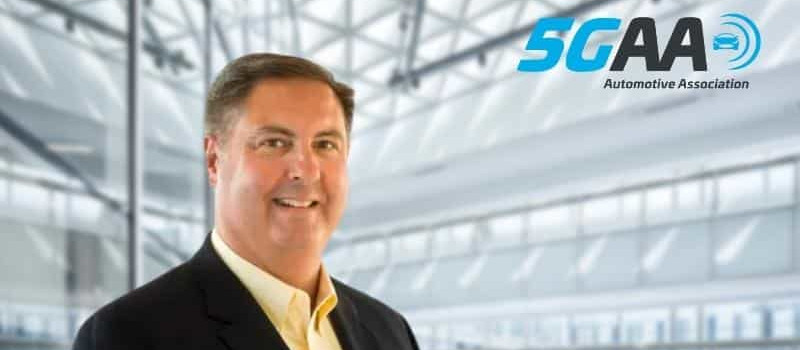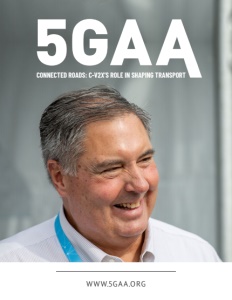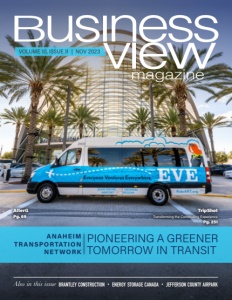The 5G Automotive Association
Connected Roads: C-V2X’s Role in Shaping Transport
‘Cellular vehicle-to-everything’ (C-V2X) developments are the ‘x-factor’ in an increasingly connected road transport sector.
Imagine a world where the biggest players in the automotive, digital, and road management sectors join forces to drive developments needed for a smoother, smarter, safer, and greener driving experience. The 5G Automotive Association (5GAA) is taking that vision forward, connecting people, vehicles, and transport infrastructure for safer and more efficient mobility.
Established in 2016 and headquartered in Munich (Germany), 5GAA is a global association comprised of automakers, telecommunications companies, equipment manufacturers and others that support innovation, standards, and policymaking developments to boost deployment of technologies leveraging fifth-generation mobile networking. The result has been the development of Cellular Vehicle to Everything, or C-V2X, solutions that encompass all road users and vehicle types.
But how does it work? C-V2X is a connected mobility platform for vehicles to interact with their surroundings, such as other cars/trucks, cyclists, pedestrians, road infrastructure (i.e. traffic lights), and mobile networks. It is reshaping how drivers and machines interact on our roads, in car parks, and other settings.
C-V2X is not a single, static solution; it is continually evolving over multiple releases under a global partnership for broadband standards. It utilizes two complementary transmission modes – direct be and network communications – to connect vehicles with one another as well as infrastructure and other road users.
Connecting individual vehicles and supporting cooperative intelligent transport systems helps to reduce congestion and pollution, C-V2X can transform how we look at traffic information, thus boosting travel efficiency and road safety.
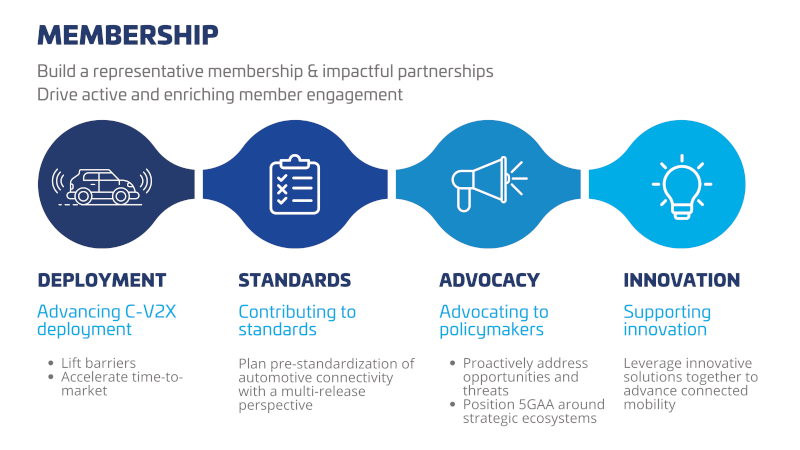 On the road… highlights
On the road… highlights
In 2022, the number of connected cars on the road topped 250 million globally, overtaking non-connected cars for the first time. Meanwhile, the number of 5G connections is forecast to reach around 2 billion this year, with a fifth of the global vehicle fleet connected to cellular networks.
While 4G dominates (90% share) the connected car market, according to a recent 5GAA White Paper, 5G automotive adoption “creates clear value and differentiation with improved customer experiences, data-driven service efficiency, and access to new and innovative business models”.
To capitalise on this potential, 5GAA looks at C-V2X, to reach the level of connectivity required for V2X communication to become what it calls a “disruptive force in the automotive market” with all stakeholders from all affected sectors – ICT, automotive, road management, both public and private – fully involved.
“Without a collective multi-sector alliance like this, all the effort to develop connected mobility use cases, including automated driving and safety solutions, would struggle to gain enough momentum on the market,” explains John Kwant, Executive Director of 5GAA, Americas.
Greater focus on innovation and technology standards is just the start. Whole new business models, investment paths and partnerships are also critical to testing, piloting and, ultimately, achieving widespread take-up of the solutions released.
According to 5GAA’s updated 2030 Roadmap for advanced driving use cases, connectivity technologies, and radio spectrum needs published late last year, fully integrating road and telecommunication infrastructures is key to C-V2X’s successful rollout. That means delivering better coverage and protection for vulnerable road users, along with enhanced capabilities thanks to more powerful and better-connected sensors onboard vehicles, carried by road users in the form of smart phones, and built into traffic infrastructure.
“The digitalisation of connected vehicles is a main driver in the ecosystem and deployments need to be in sync with the road infrastructure and user needs,” stresses the Roadmap. “Flexible and trusted communication networks are expected to bring the different players in the ecosystem together.”
Members of 5GAA recognise that hurdles remain in achieving this fully ‘connected’ community: “It is clear that future protocols, descriptions, and conformity/testing needs to prove beyond doubt that advanced automated driving use cases are safe and can deliver on their promise,” says John Kwant. “This is why we invest so heavily in technical specifications for a myriad of applications and discuss them at length with 5GAA members and related bodies.”
This year alone 5GAA has circulated technical reports on various day-one use cases, implementations, standards, and more. Topics range from automated valet parking and multi-access edge computing (MEC) for automotive applications, to the predicted evolution of vehicular communication systems beyond 5G, reliable positioning metrics for V2X applications, how C-V2X can be used for two-wheel vehicles and better safety, and more.
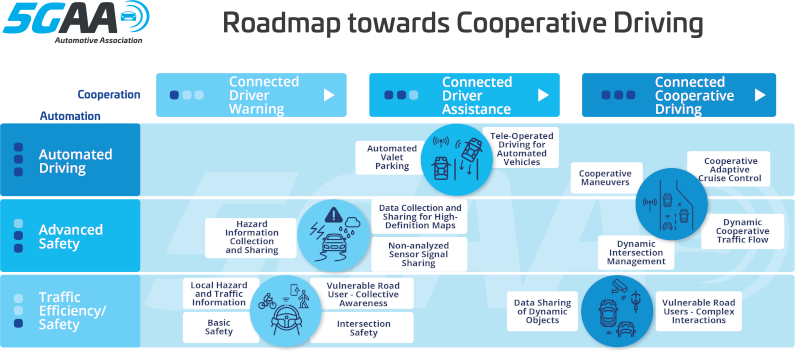 Significant progress
Significant progress
Since the release of its previous roadmap, 5GAA has observed significant growth in market deployment of C-V2X in areas such as local hazard information-sharing and several basic safety applications. A major milestone was achieved in 2017 with the completion of LTE-V2X in ‘Release 14’, with both PC5 and Uu delivering basic safety use cases. Then in 2020, 5G-V2X was completed (Release 16), covering advanced and automated driving use cases.
5G-enabled vehicles, meanwhile, have entered the market and connectivity has been acknowledged as an enabler by new car assessment programmes worldwide (e.g. local hazard warnings in Euro-NCAP 2023).
In China, 5GAA Members including General Motors, Ford and several Chinese automakers have launched, or soon plan to introduce, advanced C-V2X functionality in models using LTE-V2X. Meanwhile in Europe, the market is converging towards 5G-V2X.
Traffic efficiency use cases – addressing the likes of urban congestion, pollution/emissions, and green targets – are broadly on track, according to the Roadmap. But more mission-critical applications related to safety “have experienced different regional development and deployments”.
Wider efforts to instal trans-European corridors for driverless cars on public roads and improve road safety for drivers, passengers and other road users received a boost last year, thanks to the EU’s Vehicle General Safety Regulation.
Tighter alignment between stakeholders, including road operators seeking to digitalise road infrastructure and smart cities, is set to feature in future 5GAA Releases, according to the 5GAA Roadmap.
Moving forward…
Further progress calls for greater cooperation between mobile network operators and continued developments to guarantee connectivity – especially across borders and during complex network handovers.
More reliable connectivity also means reducing/eliminating signal dark spots (i.e. in remote areas and crowded skylines) and reaching agreement on dedicated bandwidths for C-V2X applications like automated driving.
In the US, for example, it is expected that the FCC 5.9 GHz band ruling will eventually be adopted: “This is a big decision and a game-changer for US-based 5GAA members looking to deploy C-V2X use cases, because it paves the way for mass market deployment of LTE-V2X in that band,” says John Kwant.
Members are also working on a clear path for advanced 5G developments, enabling the next set of use cases and a new roadmap release. Complementary work in ERTRAC’s CCAM Roadmap, the UK’s Zenzic Testbed, and initiatives by SAE, ICV, and Car-2-Car – will continue to inform future 5GAA’s actions covering connected, intelligent, and autonomous driving.
AT A GLANCE
The 5G Automotive Association (5GAA)
What: The 5G Automotive Association (5GAA) is a global, cross-industry organisation of companies from the automotive, technology, and telecommunications industries (ICT), working together to develop end-to-end solutions for future mobility and transportation services.
Where: München, Germany
Website: https://5gaa.org/
